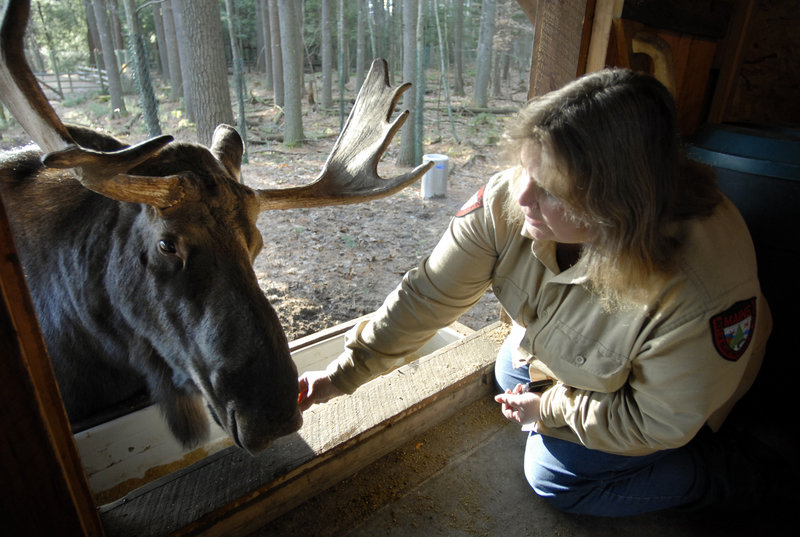Producers of the State of Maine Sportsman’s Show asked David Footer of Lewiston and me to judge the outdoors art contest, the largest of its kind in the state, and later, we ended up doing the photography contest, too.
In the most respectful manner, let me say that the photography exhibit included 10 of the most common mistakes in the world. I say “respectful” because in my younger years I made them all, so I mean no scorn.
If novice photographers listen to an experienced photographer point out errors, they can learn this hobby more quickly, particularly in this digital age. We can see the photo instantly and no longer need to wait a week or more to see photo results.
(Before digital ruled, magazines bought color slides that I had developed at quality, out-of-state labs, explaining the long delay.)
This last point about the advantage of digital cameras cannot be overemphasized. I work as an editor in my other life, and when film photography dominated, I saw successful writers who were horrible photographers. Digital capabilities improved their photos overnight.
Before David arrived and before anyone had told me we were judging the photography, I wandered around the photo exhibit.
One landscape image caught my eye. The immediate foreground looked out of focus and the horizon went across the frame’s center. The fuzzy foreground and cutting the photo in half ruined the composition — two major technique blunders in a landscape effort.
While I was standing there, an acquaintance walked by and said with disdain, “Why would anyone submit something like that?”
I smiled without comment, but it was no mystery to me. I was thinking of the answer to that question when the guy walked past. It involved a photo from my early days of photography, nearly 40 years ago.
My first roll of color slides included a photo of the Cuckolds lighthouse off Newagen. The horizon line went across the frame’s center and divided the photo in half, and the lighthouse sat in the dead center of the photo. Worse yet, I had deliberately underexposed the shot to make it look like night, an amateur attempt at being artsy, ruining the photo even more.
Back in those days, though, my work struck me as a perfect example of the second coming of Ansel Adams because a photographer’s first mistake is this: They do not know a good photo from a poor one.
We must make mistakes to learn, though, and contests put our work out where folks can critique and help us learn that much quicker.
At the photography contest earlier in the month, the most common errors fell into the following categories:
1. The horizon line cut many photos in half. One general rule dictates that the horizon should be in the bottom third, top third or diagonal to the frame — all more pleasing to the eye.
2. The main focus of a photo should be offset, bringing up another rule of thumb. Divide the photo into thirds like a tic-tac-toe game and put the photo’s dominant lines (say the horizon) and main object (my Newagen lighthouse) on the one-third lines or where those lines intersect.
Photography how-to books include lots of information on this composition guideline.
3. Fill the frame with the main subject without wasted space around it. Amateur photographers screw this one up the most. They get back too far, leading me to ask occasionally, “What’s the matter? Did a cliff or busy highway stop you from getting farther away?”
4. Astute photographers avoid cluttered backgrounds — say laundry on a line or utility wires. For example, a common setup in outdoor photography puts foliage in the near distance behind the main subject.
5. When shooting photos of people, animals and fish, focus on an eye and make sure to get a little glint of light reflecting from the eye. That brings the person or critter to life.
6. When shooting people or wildlife such as deer, make sure to shoot the photo when the subject has an animated look — some expression, so to speak. An exception to the rule might be photos of venomous snakes or dangerous game animals. In short, looking coldly sinister might be good.
7. When shooting photos of people or even wildlife, interaction between the subjects works well — say two folks talking or animals looking at one another. (I once shot a photo of a river otter “kissing” its companion otter, a successful image.) A hero shot of an angler with a fish should have the person looking at the fish rather than the camera.
8. A huge and common error at the photography contest was camera movement, which creates slightly out-of-focus lines. A faster shutter speed or a tripod or monopod sharpens photos.
9. Using a smaller f-stop such as f-16 creates more depth of field than a large opening. For example, a photographer might be doing a scenic with an old fence in the foreground and a pond in the background. The fence should be as sharp as the horizon, which requires depth of field.
10. Rules are meant to be broken artfully.
Ken Allen of Belgrade Lakes is a writer, editor and photographer. He can be contacted at:
KAllyn800@yahoo.com
Send questions/comments to the editors.



Success. Please wait for the page to reload. If the page does not reload within 5 seconds, please refresh the page.
Enter your email and password to access comments.
Hi, to comment on stories you must . This profile is in addition to your subscription and website login.
Already have a commenting profile? .
Invalid username/password.
Please check your email to confirm and complete your registration.
Only subscribers are eligible to post comments. Please subscribe or login first for digital access. Here’s why.
Use the form below to reset your password. When you've submitted your account email, we will send an email with a reset code.